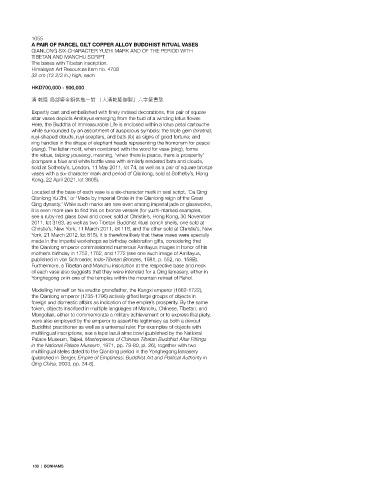Page 132 - Bonhams IMages of Devotion, Hong Kong Nov 30 2022
P. 132
1055
A PAIR OF PARCEL GILT COPPER ALLOY BUDDHIST RITUAL VASES
QIANLONG SIX-CHARACTER YUZHI MARK AND OF THE PERIOD WITH
TIBETAN AND MANCHU SCRIPT
The bases with Tibetan inscription.
Himalayan Art Resources item no. 4708
32 cm (12 2/3 in.) high, each
HKD700,000 - 900,000
清 乾隆 局部鎏金銅供瓶一對 「大清乾隆御製」六字篆書款
Expertly cast and embellished with finely incised decorations, this pair of square
altar vases depicts Amitayus emerging from the bud of a winding lotus flower.
Here, the Buddha of Immeasurable Life is enclosed within a lotus petal cartouche
while surrounded by an assortment of auspicious symbols: the triple gem (triratna);
ruyi-shaped clouds, ruyi scepters, and bats (fu) as signs of good fortune; and
ring handles in the shape of elephant heads representing the homonym for peace
(xiang). The latter motif, when combined with the word for vase (ping), forms
the rebus, taiping youxiang, meaning, ‘when there is peace, there is prosperity’
(compare a blue and white bottle vase with similarly rendered bats and clouds,
sold at Sotheby’s, London, 11 May 2011, lot 74, as well as a pair of square bronze
vases with a six-character mark and period of Qianlong, sold at Sotheby’s, Hong
Kong, 22 April 2021, lot 3605).
Located at the base of each vase is a six-character mark in seal script, ‘Da Qing
Qianlong Yu Zhi,’ or ‘Made by Imperial Order in the Qianlong reign of the Great
Qing dynasty.’ While such marks are rare even among imperial jade or glassworks,
it is even more rare to find this on bronze vessels (for yuzhi-marked examples,
see a ruby-red glass bowl and cover, sold at Christie’s, Hong Kong, 30 November
2011, lot 3163, as well as two Tibetan Buddhist ritual conch shells, one sold at
Christie’s, New York, 11 March 2011, lot 118, and the other sold at Christie’s, New
York, 21 March 2012, lot 815). It is therefore likely that these vases were specially
made in the imperial workshops as birthday celebration gifts, considering that
the Qianlong emperor commissioned numerous Amitayus images in honor of his
mother’s birthday in 1752, 1762, and 1772 (see one such image of Amitayus,
published in von Schroeder, Indo-Tibetan Bronzes, 1981, p. 552, no. 158B).
Furthermore, a Tibetan and Manchu inscription at the respective base and neck
of each vase also suggests that they were intended for a Qing lamasery, either in
Yonghegong or in one of the temples within the mountain retreat of Rehol.
Modelling himself on his erudite grandfather, the Kangxi emperor (1662-1722),
the Qianlong emperor (1735-1796) actively gifted large groups of objects in
foreign and domestic affairs as indication of the empire’s prosperity. By the same
token, objects inscribed in multiple languages of Manchu, Chinese, Tibetan, and
Mongolian, either to commemorate a military achievement or to express filial piety,
were also employed by the emperor to assert his legitimacy as both a devout
Buddhist practitioner as well as a universal ruler. For examples of objects with
multilingual inscriptions, see a lapis lazuli alms bowl (published by the National
Palace Museum, Taipei, Masterpieces of Chinese Tibetan Buddhist Altar Fittings
in the National Palace Museum, 1971, pp. 79-80, pl. 26), together with two
multilingual steles dated to the Qianlong period in the Yonghegong lamasery
(published in Berger, Empire of Emptiness: Buddhist Art and Political Authority in
Qing China, 2003, pp. 34-6).
130 | BONHAMS

